Uncategorized
They have marched for 90 Sundays in Montreal, in solidarity to bring the hostages home
Shiri Tamam did the unusual last Wednesday night, closing her phone when she went out with friends in Tel Aviv. It was only when she arrived back in her room in the early morning hours did she learn a deal to release all the hostages had been signed.
The Montrealer spent this past October 7 helping to clean up Dizengoff Square and rearranging photos of October 7 victims and hostages, filled with nervous energy as the hour drew near to the impending release that she and millions of others had longed for after two long years, up until the moment the deal brokered by U.S. President Donald Trump was accepted.
And like the Sundays before it, back home after three weeks in Israel, Tamam joined her neighbours, and Jews and non-Jews from across the island, to march in the local Bring Them Home rally through Montreal’s west end, associated with the Israel-based Hostages and Missing Families Forum.
For 90 Sundays—with one Sunday cancelled due to perilous road and sidewalk conditions—the group ranging in size from 30 stalwarts to more than 200, have made the journey, hoisting hostage posters high in the air along with Israeli, Canadian, Quebec, Syrian and Iranian flags, flanked by municipal security patrols and Montreal Police.
For 90 Sundays, the march has brought together young and old, Holocaust survivors and day-schoolers, observant and secular, Ashkenazi and Sephardi, French and English, in solidarity, beginning on the 100th day following the October 7 terrorist slaughter and mass kidnapping in Israel.
The route has changed, sometimes short and linear, others extended, circuitous, passing through three west-end municipalities with gatherings at the local Jewish community campus, where participants met and heard from a wide variety of guest speakers. From hostage families and IDF soldiers on active duty on October 7, to occasional visits from politicians and others.
In stifling heat under burning sun, or dark, frigid days on curbs completely encased in thick ice, people came. A few falls, a few twisted ankles, some sore hips, and lots of tears, not from the falls, but the agony of it all.
On this 90th Sunday, the electricity was palpable, as the cease-fire was days old and all eyes were on the clock as 20 presumed living hostages were set to be released. Faces betrayed angst, joy, and there was no shortage of opinions on what should or could happen next. Also on this Sunday, a sunny crisp fall day under blue skies, the march was silent: no thunderous calls of “Bring them home!” or “Libérer les otages!”—just silence, walking with signs and flags held aloft by more than 120 people, some holding hands, some alone, some pushing strollers.
On this 90th Sunday, Tamam was back as always with her dog in tow, but this time also toting a poster direct from hostage square. She says her last days in Israel saw people bristling with cautious optimism, “as if they didn’t want to talk about it and were scared to be hopeful. We were so close so many times, and then something happened, and then last Saturday night, before the deal, I went to hostage square and there were 200,000 people. It ended without even singing Hatikvah.”
As if singing of hope, she said, could have scuttled a deal. After the deal announcement “the feeling was joy, but not pure joy, and I don’t think it’ll ever be pure joy. It’s a Jewish thing. Like Yom HaZikaron (memorial day for fallen soldiers and terrorism victims) and Yom Ha’atzmaut (Independence Day) mode, we appreciate life, celebrate it, but there’s a cost to everything.”
Her joy is sharing space with worry. “In a couple of days, I will start talking about the day after, because I don’t feel Hamas is going anywhere. I feel like it’s a ticking time bomb, and I hope in my heart that the Israeli government learned a lot of lessons since October 7, 2023, and will react accordingly.”
For 90 Sundays, the crowd stood rapt before taking their first step; as speakers recited Torah passages, others told stories of October 7 survivors, and still others spoke of missions to Israel and projects to help traumatized Israeli children. The testimony of witnesses also took a big place, as did motivational words to help sustain the group through another week in a city where Montreal’s Jewish community has been increasingly under pressure by campaigns of harassment and erasure.
On this 90the Sunday, co-organizer Tali Juran quoted freed hostages and their families, all under the veil of Israeli superstition. “For the first time, we have an ending in sight, and a very close one at that. But we’re Israelis, so we are not celebrating yet. Furthermore, we have made a deal with the devil, so it ain’t over until it’s over.”
Through the various hostage releases, war with Iran and decimation of Hezbollah; local fire-bombings, threats, and assaults on Jews; the murder of a young couple outside an American Jewish museum, and the deadly flamethrower attack on Jews by a pro-Palestine suspect at a sister march in Boulder, Colorado, Montreal Jews and their allies have gathered in this west-end park, greeting each other with hugs and ribbons, songs and prayers, and no two weeks have been alike.
For some, that ticking clock and promise of imminent resolution to the hostage crisis seemed an almost insufferable wait, seemingly choosing silence for fear of some cosmic insult bringing misfortune to the process.
Toby Moneit was torn between excitement and an instinctive reflex to restrain her enthusiasm. “I’m not letting myself be excited, because we never know. As I’ve been joking with a lot of people, the shtetl in me keeps saying ‘ptui ptui ptui’ because it’s a very Jewish thing to caution that enthusiasm.”
Moneit is scared. “Very scared that something could happen, that they’ll do something to the hostages as they’re about to exchange them or send them back, or there will be another attack on Israel as the deal is happening, or in the months to come, or on a Jewish community here.” Even on this 90th Sunday says the cégep business teacher, “I’m even worried here, that we’re excited and that would be an interesting time to take advantage of us, thinking we’ve lowered our guard.”
Moneit is horrified that agitation and calls for escalation are continuing in western streets, including in Montreal where pro-Palestinian groups called for continued resistance, and at least one messaging that those making peace in Gaza were traitors. “Whatever happens in the Middle East,” she told The CJN. “I don’t think this is going to let up on campuses.”
“Israel is an imaginary place and living rent-free in a lot of people’s minds. They don’t know what Israel is, what Jews are, what the Jewish community is and yet they place Israel and Jews at the center of all their grievances.” She said that comes with total inversion of concepts “that were more traditionally liberal, like academic freedom, like democracy. Here we are two years after October 7 and those very same people who ran seminars, made videos and taught about securing safe in defence of minoritized communities are the very same people who are now talking about academic freedom and that Jewish students need to learn how to be uncomfortable. Literally, word for word, saying that.”
On this 737th day since the terrorist attack, at the end of this 90th march, co-organizer Ruben Hassan, who stood on a park bench on an icy January morning reading his own tearful and solemn message to slain hostages Shiri, Ariel and Kfir Bibas and has read out repeated prayers for the lost lives, today was smiling. “We have the strongest community” he told The CJN. “That’s why I think the world hates us. When something happens to one of us, all of us are behind them, and we all go together, cry together and are happy together.”
He too remarked the palpable difference in the crowd. “It’s the first time we all come with a smile. For two years, every Sunday people were sad and almost crying, and it’s the first day that no one cried. Everyone was smiling, and we have hope. For the first time since October 7, we have real hope. Thanks to Mr. Trump, we’re going to have peace.”
Hassan also hopes some normalization will return to western cities, he himself cautioned frequently by Montreal Police to avoid certain parts of town given the onslaught of threats and animus targeting him owing to his prolific role in local Jewish advocacy. “We will never be the same. We will try to start a new life but will remember everything. That’s the Jewish experience. We have to remember our story. We remember the destruction of the First Temple, of the Second Temple. Of the Shoah. It’s our life. It’s how we walk. This is how we are built.”
On this 90th Sunday, Hampstead town councillor and march regular Jack Edery said “regardless of whether we’re in Israel or in Montreal or Toronto or Shanghai, the Jewish body is united and we feel the loss when any one of us is in captivity. God willing,” he says, “the hostages will come home and the soldiers will come home, and there’ll be some kind of lasting peace.”
That optimism is tempered by the involvement of Hamas. “We didn’t negotiate a deal with Switzerland; their word is as good as nothing and they didn’t do this deal because of the goodness of their hearts, but because they had no choice, and wanted to survive rather than die on that sword. We’ll only know when the hostages are home.”
March regular Steven Spodek is also looking forward but insists everyone must remember the families who have endured two years of tremendous suffering, “and many of them will continue to go through hell. We also can’t lose sight of the fact that this will impact people for years in terms of PTSD,” while concerned that the Israeli government will lack sufficient resources to alleviate that suffering.
“But coming here for the last 90 weeks, people have asked what difference does it make? First of all, it has been an opportunity for people who care and are concerned to come together once a week and exchange ideas and chat. We have also had people from Israel come and speak to us, including those who have lost loved ones. Most importantly is that there are people here amongst us who are able to send videos and messages so those in Israel shouldn’t feel like nobody is thinking about them.”
Edery said if all goes smoothly it will be a relief to see the weekly march pass into history. “When the hostages come home, we have to have a moment of silence for the ones who were murdered. We will say Kaddish for them, and then, in the same way that we do Yom HaZikaron and Yom Ha’atzmaut, we have to switch over and party and celebrate it.” He’s also looking forward to the next step, ironically a “move back towards to what we were doing prior to October 7; expansion of the Abraham Accords. Let’s get back to forging peace.”
For her part, Tamam will say a prayer before shutting her eyes on this 90th Sunday, “but not shehecheyanu (a Jewish prayer to acknowledge special occasions). I’m saying celebrate and be hopeful, but I will only say shehecheyanu when every single one of them is back in Israel. Alive or dead.
“But they need to be back.”
The post They have marched for 90 Sundays in Montreal, in solidarity to bring the hostages home appeared first on The Canadian Jewish News.
Uncategorized
‘An Evening of Tears’: Israeli Hostages, Bereaved Relatives Voice Mixed Emotions Ahead of Release Deal

Israeli President Isaac Herzog speaks as he visits a site next to “Hostages Square” amid a ceasefire between Israel and Hamas in Gaza and ahead of the expected return of hostages held in Gaza, in Tel Aviv, Israel, Oct. 12, 2025. Photo: REUTERS/Stoyan Nenov
The families of Israeli hostages, fallen soldiers, and terror victims voiced their feelings Sunday night about the pending hostage release from Gaza, on what Prime Minister Benjamin Netanyahu described as “an evening of tears and happiness.”
Ilan Dalal, the father of hostage Guy Gilboa-Dalal, said he hoped to hug his son and “tell him that the nightmare is over.” But he also said he didn’t know “what kind of son I’m going to get back.” In the last video released of Guy by the Palestinian terrorist group Hamas, Dalal said he saw “despair in his eyes,” adding his hope that he would be able to “rebuild his life.”
Dalal spoke alongside former hostage Tal Shoham on a Zoom call with members of the press. Dalal’s son was held in the tunnels in Gaza along with Shoham, Omer Wenkert — who has since been released — and Evyatar David, who is set for release on Monday.
Shoham thanked US President Donald Trump for “making the impossible possible” and said he wished he could shake the president’s hand “not only for this deal but for the deal that released me.”
Trump departed for Israel and Egypt on Sunday to celebrate the US-brokered ceasefire and hostage-release deal between Israel and Hamas to halt fighting in Gaza. The war began with Hamas’s Oct. 7, 2023, invasion of and massacre across southern Israel, during which Palestinian terrorists from Gaza murdered 1,200 people and kidnapped 251 hostages.
In his remarks Sunday evening, Netanyahu called the impending releases “a historic event, which some did not believe would ever happen,” and urged Israelis to set aside their differences.
“With joint strength, we achieved spectacular victories,” he said, while warning that the military campaign was not over. “There are still major security challenges ahead of us. Some of our enemies are trying to recover in order to attack us again but we are on this.”
Not everyone supported the deal, which would see around 2,000 Palestinian prisoners released in exchange for the remaining 48 hostages, 20 of whom are believed to be alive.
Brenda Lemkus, whose daughter Dalia was murdered in a 2014 stabbing attack in the West Bank, joined other bereaved relatives from the Choosing Life group — which opposes prisoner releases — in condemning the decision to release her daughter’s killer.
“Releasing him invites the next murder immediately,” Lemkus said. “The blood of those murdered is on the ministers who voted for this.” She called on Israel to institute the death penalty for terrorists.
Michael Nurzhitz, brother of reservist Vadim Nurzhitz, said that while he was happy for the hostages and their families, releasing Raed Sheikh — the terrorist and Palestinian police officer responsible for his brother’s murder — was “unfathomable,” especially ahead of the 25th anniversary of the incident.
Vadim Nurzhitz and fellow Israel Defense Forces (IDF) reservist Yossi Avrahami were lynched in Ramallah on Oct. 12, 2000, after accidentally entering the city and being taken into custody at a Palestinian police station.
“If they release the murderer, the terrorist will return to terror, just like those released in the Shalit deal — they will return to murder us,” Nurzhitz said, referring to the 2011 exchange that freed Gilad Shalit in return for more than 1,000 Palestinian prisoners, including Yahya Sinwar, who later masterminded Hamas’s Oct. 7, 2023, invasion of and massacre across southern Israel.
Choosing Life petitioned the High Court against the move, saying “the blood of our children has turned into a tradable commodity.”
Eliya Atias, whose son Eden was stabbed to death while he was sleeping in 2013, said the release of his son’s murderer was a sacrifice she “felt good” about making if it meant freeing the hostages.
“I am a believing Jew who believes that the Creator will pay him back,” she said. “I feel that thanks to my act, I am saving the lives of my brothers in Gaza.”
Emotions were also mixed at a Sukkot event attended by 2,000 bereaved Israelis, organized by OneFamily, which supports victims of terror and their families.
Hagit Rosenzweig, whose son, Staff Sgt. Eitan Rosenzweig, was killed in Jabalia in north Gaza early in the war, called it a “very complex day.”
“We are very happy that the hostages are returning, and that families are being reunited. But our son isn’t ever coming home,” she said.
Meir Hershkowitz, whose son Netanel was also killed in Jabalia in October 2024, said he was “thrilled for the families” but urged Israelis not to forget those who were killed.
Both Rosenzweig and Hershkowitz said they found solace in being with others who shared their loss. “Especially during the holidays when the absence is most deeply felt. Being here with other families who understand the same pain is powerful,” Hershkowitz said.
On the Zoom call, Dalal described the rollercoaster of the past two years, noting many moments of “great despair,” but said he reminded himself that his son was “counting on him to be his voice” from inside the tunnels of Gaza.
“We didn’t have the option to break down,” he said.
Shoham said he endured “torture, cruelty, and starvation” during his captivity. Hamas withheld food as “sadistic psychological warfare,” keeping them on “200 or 300 calories a day” — first “to make us suffer,” and second “to pressure Israeli society,” he said. He described seeing “boxes and boxes and boxes” of aid diverted by captors who bragged of having supplies “for months ahead,” while refusing to share it with hostages in the tunnels.
Shoham distinguished between Hamas and the people around them, while conceding, bleakly, how porous that boundary had become. “I know that there are people who support Hamas — I don’t know if it’s all of them but a lot of them are part of Hamas and are disguised as civilians.”
His guards, he noted, had ordinary jobs. “One was a first-grade teacher, another was a lecturer at a university, and another was a doctor. These are normal people becoming terrorists.”
Shoham also described the mindset that helped him survive.
“I consider myself a spiritual person on a spiritual journey. I believe human life has a purpose,” he said. “During captivity, I tried to do everything in my power to honor my life, no matter what they would do to me. We’re not responsible for the terrible things our enemies will do — or even for any deals that are made. Our only mission is to become better each day and to cleanse ourselves from the cruelty and hell we went through.”
Uncategorized
His son is due to be released from Gaza imminently. Ilan Dalal is grateful — and not just to Trump.
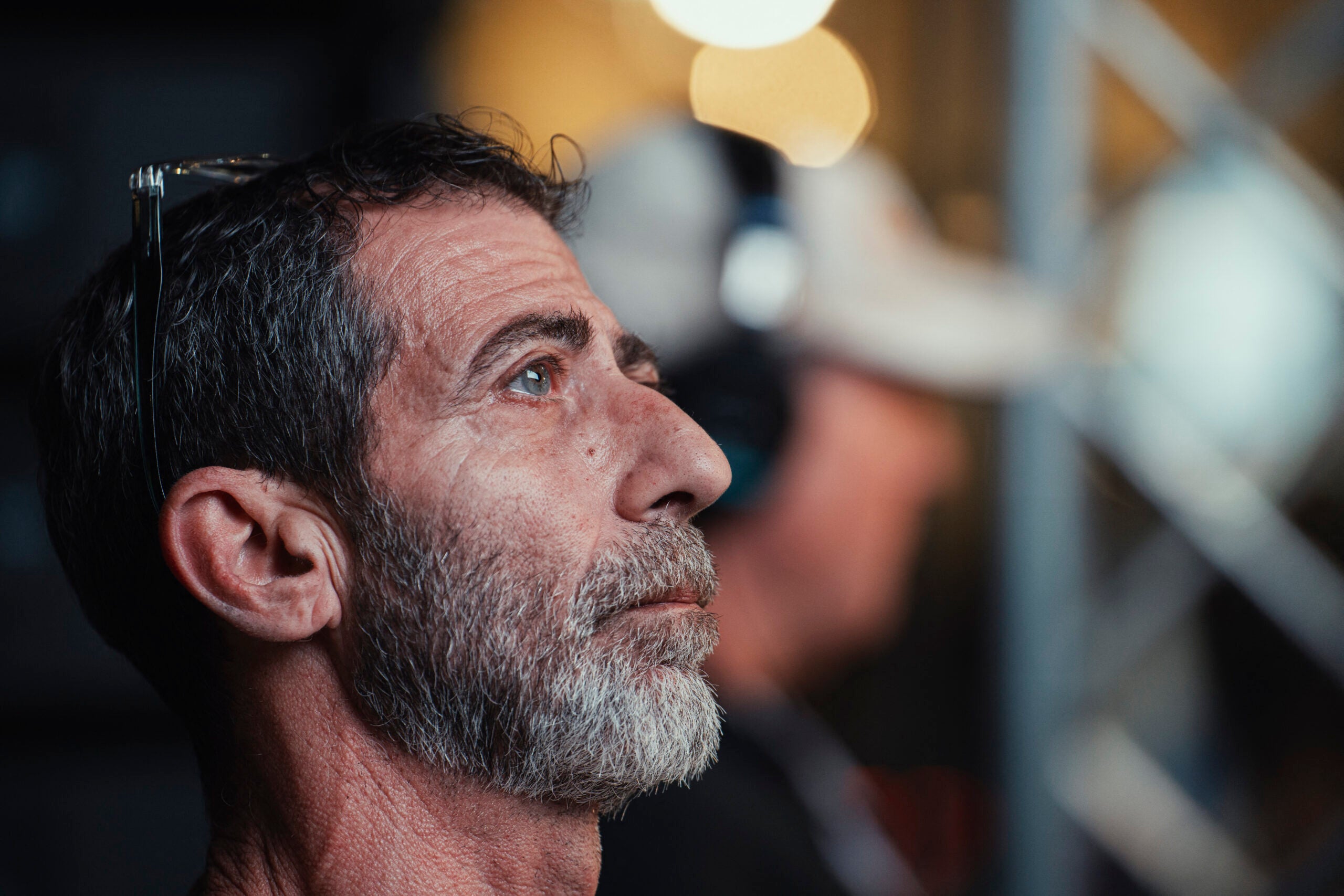
Hours before Monday’s expected hostage handover, Tal Shoham, who spent more than 500 days in Hamas captivity, and Ilan Dalal, father of hostage Guy Gilboa-Dalal — with whom Shoham was held — expressed gratitude to both President Donald Trump and, in a rare moment for hostage families, to the Israeli government.
“Thanks to President Trump for making the impossible possible,” Shoham said, alongside Gilboa-Dalal on a Zoom call with reporters.
Shoham said he was “allowing himself to hope” for the release of his fellow captives on Monday, but was also trying to block those feelings, “so I won’t break if it does not happen.”
He added his regret about not being invited to meet Trump. “I wanted to shake his hand and thank him — not only for this deal but for the deal that released me.”
Shoham was abducted from Kibbutz Beeri on Oct. 7 with his wife, two young children and other relatives. The women and children were freed in November 2023, and he was released in February this year.
Meanwhile, Ilan Dalal, whose son was taken hostage by Hamas terrorists from the Nova festival, said the first thing he would do when he encounters Guy after his release was “hug him, smell him and tell him that the nightmare is over.”
But he went on to say that didn’t know “what kind of son I’m going to get back,” citing the last video released of his son, in which he saw “despair in his eyes.”
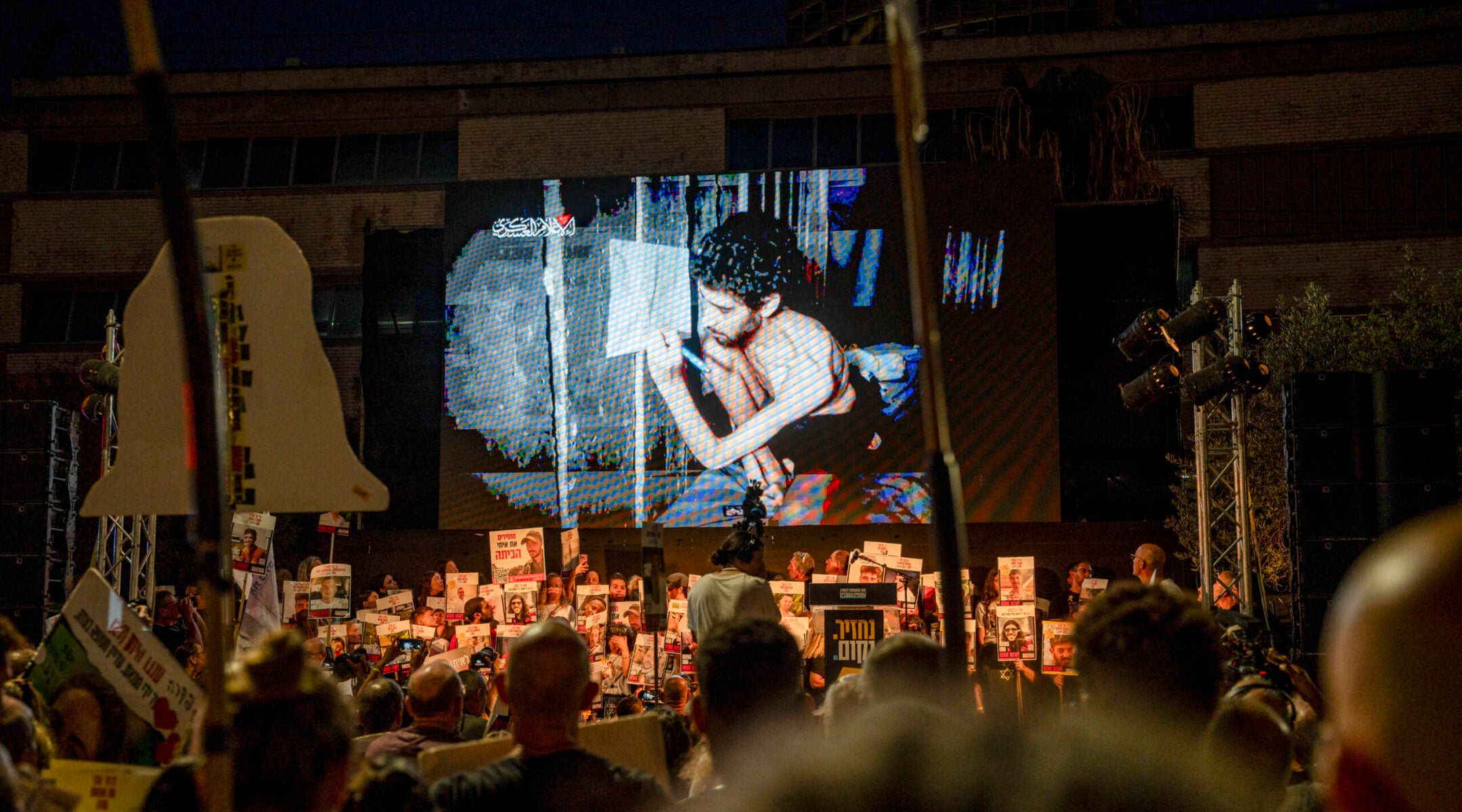
An image of Evyatar David from a video released by Hamas is shown at a rally in Tel Aviv, Aug. 2, 2025. (Ori Aviram/Middle East Images via AFP/Getty Images)
“We saw him not the way we knew him. We know Guy as he was two years ago, but after he went through two years of suffering, of starvation, of humiliation, both physical and mental abuse, we don’t know how these things are going to affect him,” Dalal said. “I hope that he will not be so harmed that he cannot rebuild his life.”
Shoham spoke at length of his captivity saying that he was “intentionally starved … for sadistic psychological warfare” receiving between 200 and 300 calories a day to share with fellow hostages Guy and Evyatar David — also set to be released on Monday — first, “to make us suffer,” and second “to pressure Israeli society.”
He went on to say that his Hamas captors boasted about stealing humanitarian aid.
“I saw with my own eyes that they stole boxes and boxes and boxes of humanitarian aid from Egypt, from Turkey, from the Emirates, but they didn’t agree to give us any of this food in the tunnels,” he said.
But after the February release of Eli Sharabi, Or Levy and Ohad Ben Ami, all of whom were severely malnourished, his captors began giving “much, much more food,” he said, adding that it was dangerous because they were suffering from malnutrition. “It could have killed us.”
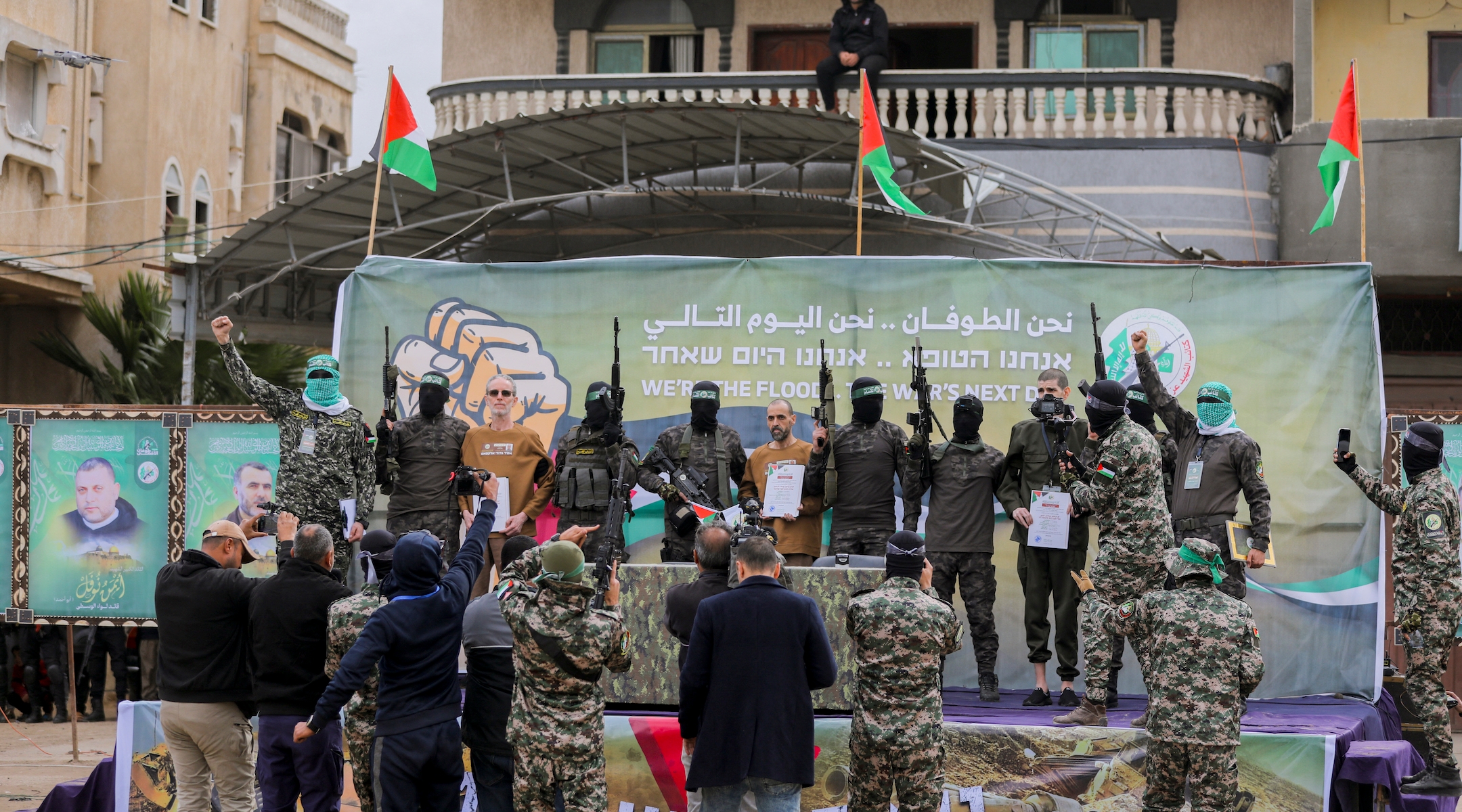
Israeli hostages stand on stage flanked by Hamas militants during the official handover in Gaza, Gaza Strip, on February 8, 2025. (Youssef Alzanoun / Middle East Images / Middle East Images via AFP)
Shoham said his time in captivity included “a lot of torture and cruelty.” Asked to describe one of the worst moments, Shoham declined, saying “disconnecting from the experience” helped him keep on fighting.
“I don’t want to go there,” he added.
Citing unnamed sources, Israel’s Channel 12 News on Sunday evening said the government has assessed that some of the living hostages set to be freed on Monday have undergone torture.
The Red Cross reported that it had seen some of the hostages and found some in serious condition, according to Israeli journalist Ronen Bergman.
Shoham described his captors as “so brainwashed and full of hate” but for some of them, it didn’t stem from religious motives.
“Some of them [were] religious, but some were only there because this is the popular thing to do. They can take all sadistic thoughts and actions not just against Israelis but also Gazans.” He recounted one incident he had witnessed, in which a Hamas operative shot a Gazan man in the knees because he “looked suspicious,” and later, when the injured man was being attended to by an ambulance, he was executed outright because “they decided that he should die.”
There were moments of humanity, he said — noting that Islam has rules for how to treat captives — but they were “very rare,” and cited instances in which his captors brought him smuggled food and a message from his wife.
He went on to say that most of them were “not soldiers.”
“One of the guards was a first-grade teacher, another was a lecturer at a university, and another was a doctor. These are normal people becoming terrorists,” he said.
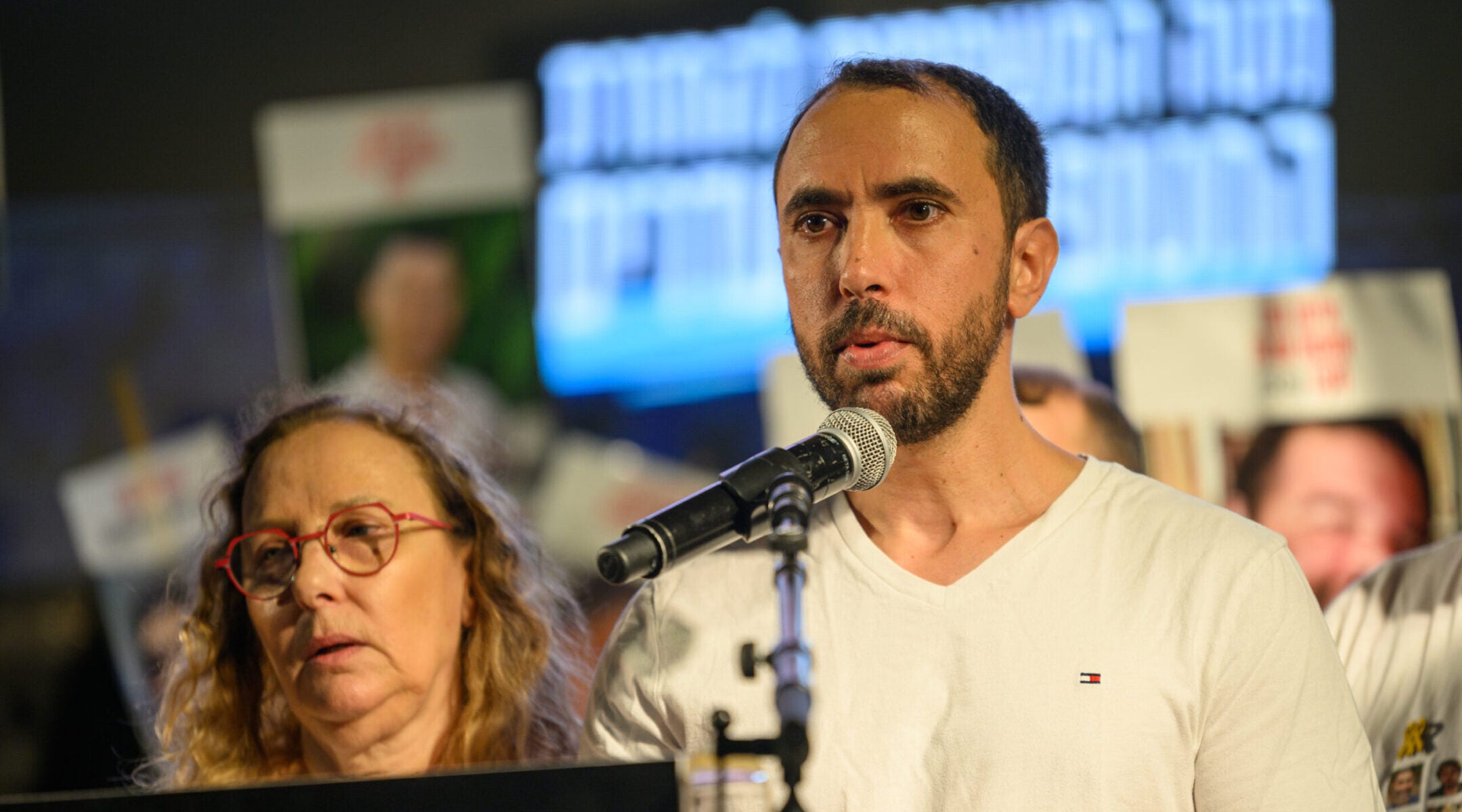
Released hostage Tal Shoham speaks at the weekly “Bring Them Home” rally in Hostages Square on Oct. 11, 2025 in Tel Aviv. (Photo by Alexi Rosenfeld/Getty Images)
Captivity, Shoham said, “forced me to go inward.”
“Only a few people mattered to me — my family and a few close friends,” he said, adding that hearing of his wife and children’s release on the 50th day of their captivity was “tremendous” in helping him get through his ordeal.
The experience also intensified his faith. “I have a lot of gratitude for life. My faith in humanity and in God only increased. It is much more spiritual and religious than before.”
He credited the state with steady support once he came home. “I felt a lot of support from the government — I have a psychologist, financial support — anything that I needed was taken care of. I personally felt a lot of gratitude to my country in these days.”
Asked if he felt any misgivings towards the government for not securing a deal earlier, Ilan Dalal also struck a conciliatory tone.
“Of course we would have wanted it to be much earlier,” he said. “But the Israeli government also needs to think about the security of Israel. Probably there were a series of processes that needed to be completed before we got to this point.”
He described the psychological toll he and his family had suffered over the past two years. “Sometimes I woke up in great despair,” he said. “Sometimes I had no strength to get out of bed. But then I remembered my son in the tunnels. That he’s counting on us to be his voice. We didn’t have the option to break down.”
—
The post His son is due to be released from Gaza imminently. Ilan Dalal is grateful — and not just to Trump. appeared first on Jewish Telegraphic Agency.
Uncategorized
How Abe Kugielsky’s photos of Hasidic Brooklyn ended up on display in Grand Central Terminal
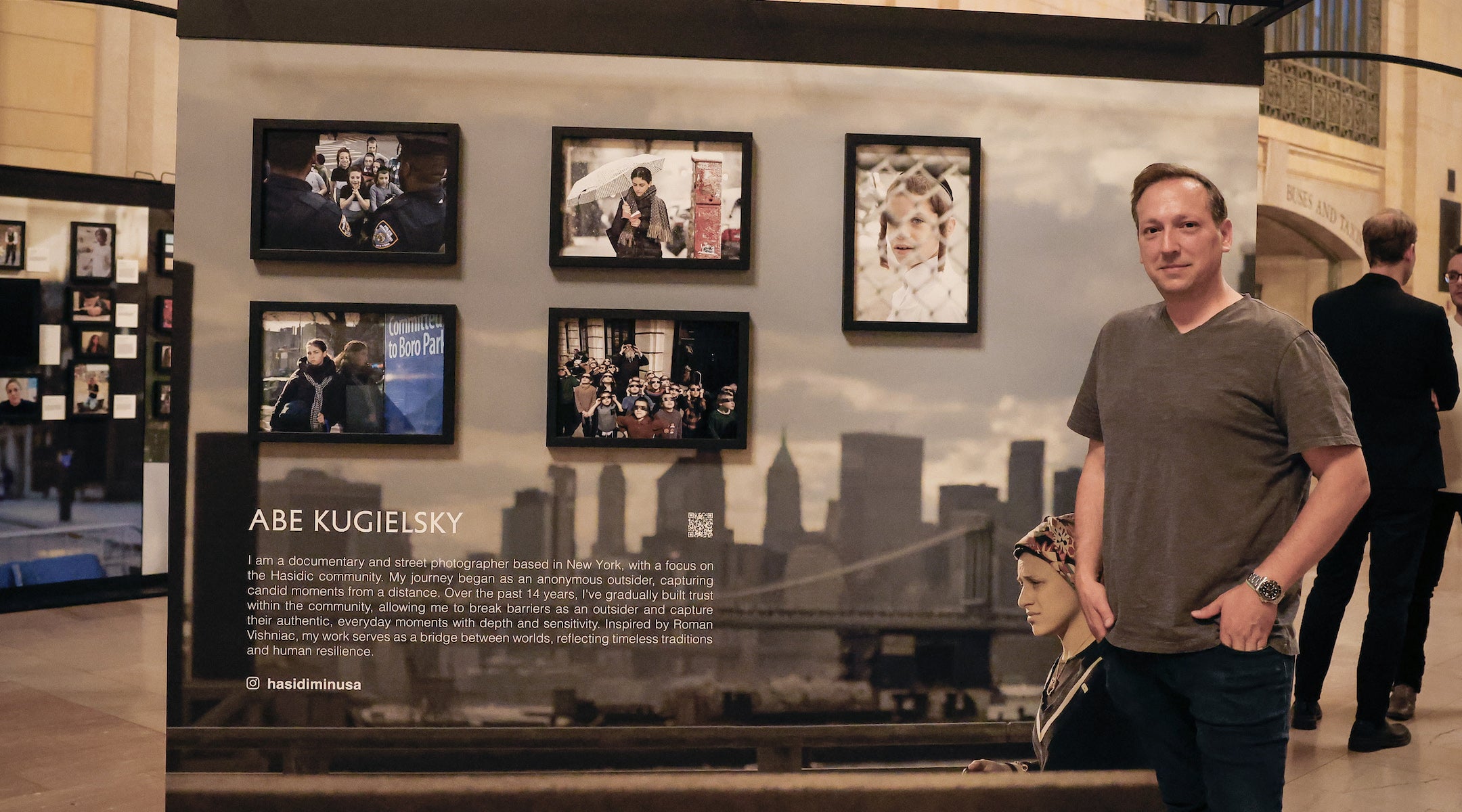
When Abe Kugielsky first began photographing the Hasidic Jewish community in Borough Park, Brooklyn, in 2010, he was an outsider with a camera, met with resistance from a community unaccustomed to being documented.
But by 2017, he had amassed a bank of roughly 50,000 photographs, and decided it was time to start posting his images to an Instagram account he called “Hasidim In USA.”
Today, his account has drawn 80,000 followers curious for a glimpse inside a traditionally private world. And this month, it has also landed him a place in Humans of New York’s “Dear New York” exhibition in Grand Central’s Vanderbilt Hall. The free exhibition, curated by Brandon Stanton of the online photo sensation Humans of New York and including dozens of local photographers, runs until Oct. 19.
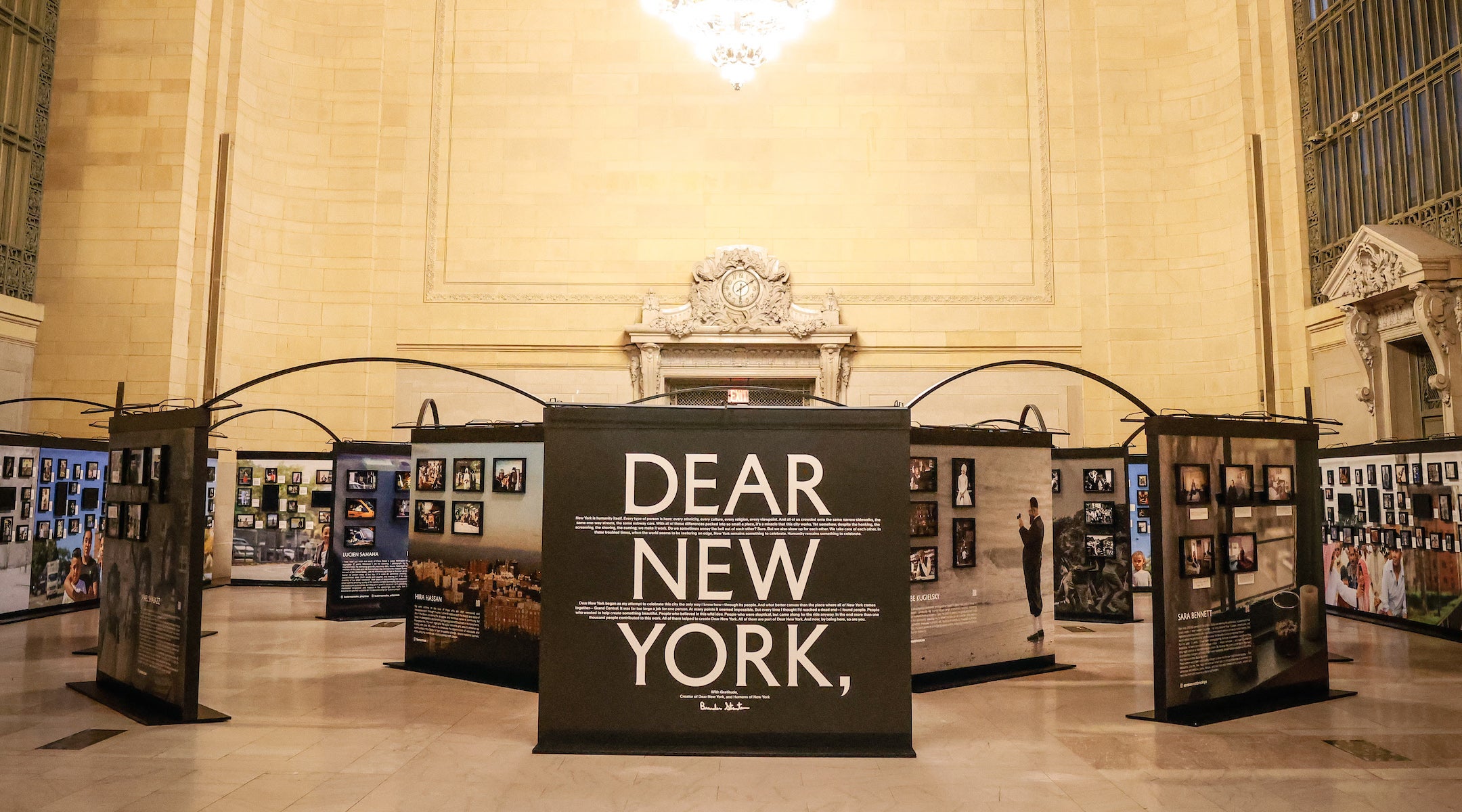
A view of Humans of New York’s “Dear New York” exhibition in Grand Central’s Vanderbilt Hall, running from Oct. 6 to Oct. 19. (Courtesy Abe Kugielsky)
By day, Kugielsky, who is 45 and identifies as Modern Orthodox, runs a Judaica antique auction house in Cedarhurst, Long Island. But his photography, and efforts to gain inroads in the Hasidic community, have become his true passion.
“Judaica is my full-time job, but I will close shop whenever I feel like I need a day off to go,” said Kugielsky. “It’s very therapeutic to me when I go out to shoot, I’m in my own little bubble, my own zone.”
This interview was condensed and lightly edited for clarity.
JTA: What first drew you to photographing the Hasidic communities in New York?
Kugielsky: When I moved to Brooklyn after we got married, my wife had a job in Borough Park. I would drive her to work every day. I had started street photography as a hobby back in Israel a little bit, and then got married and I let go of it. But when I started visiting Borough Park every morning, and I was getting that Roman Vishniac vibe by seeing the scenes, and I figured, I’ll pick up a camera and start documenting something that’s been untouched in New York.
It’s been very popular in Israel. There’s so many photography books on Orthodox life in Jerusalem, but there’s nothing about Hasidic life in America. There’s one book from like 1974, a small book with some photos, but that’s about it. It’s really very little. So I felt like it was an untouched niche, and I picked up a camera and I started photographing.
How do you build trust with your subjects in a community that is often described as insular?
To see someone walking on Borough Park with a camera taking pictures is not common. It’s not Mea Shearim [the Jerusalem neighborhood] where we have tourists and Americans and photographers. This is very uncommon, so there was a lot of fear of resistance, and of course, the resistance came. So it started off really more in hiding from distance, and over time, I built trust in the community to a point where they celebrate me.
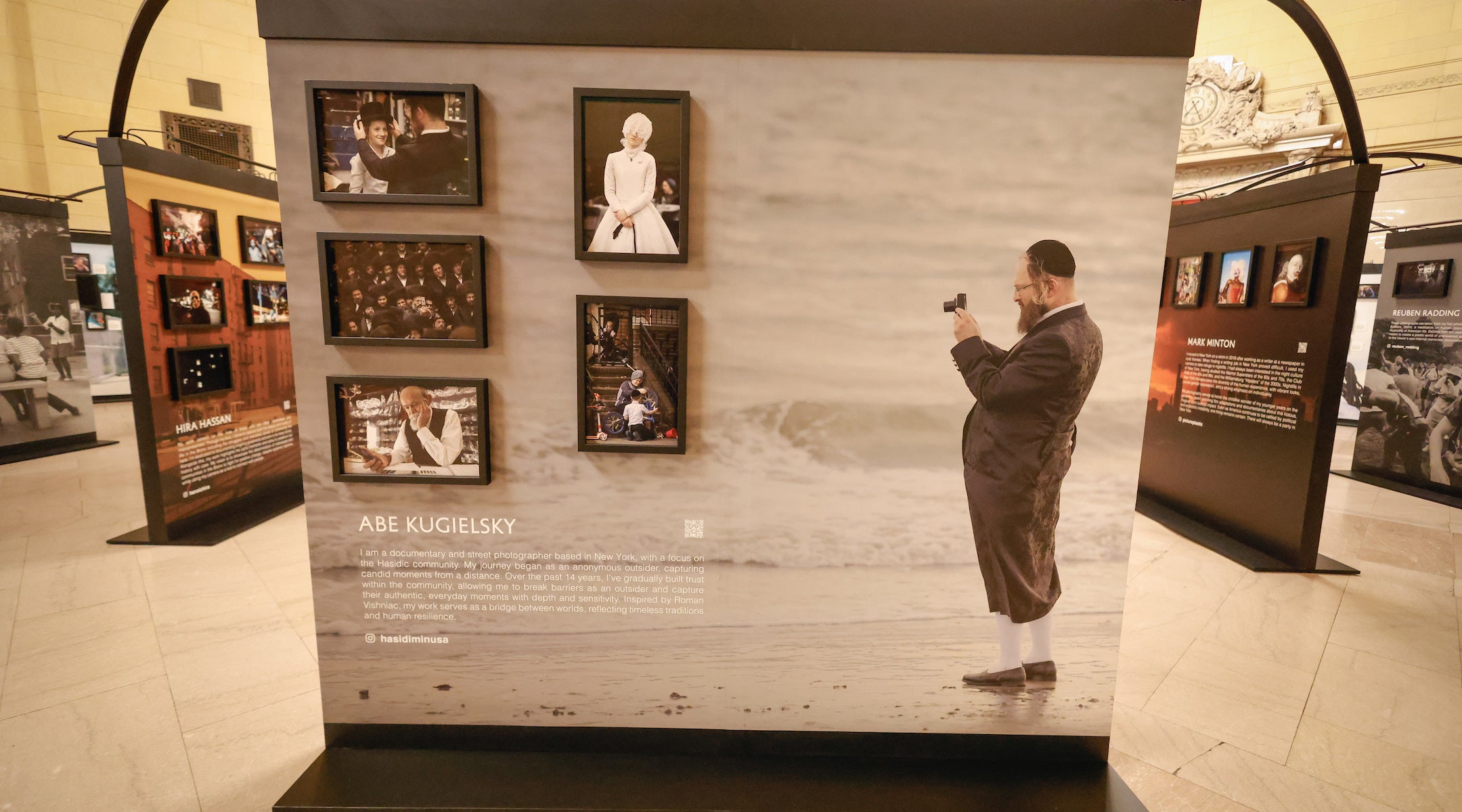
Abe Kugielsky’s installation at Humans of New York’s “Dear New York” exhibition in Grand Central’s Vanderbilt Hall, running from Oct. 6 to Oct. 19. (Courtesy Abe Kugielsky)
I made it my goal to post in a very positive light, either a positive caption or a positive scene or a positive story, to show them I’m not here to bring out what everyone else has been doing. I realized over the years that it’s really rooted a lot in generational trauma, where, whenever media came into Borough Park or Williamsburg, it was always for a negative story, and that’s where the resistance really came from. So over time, when they recognized that my work is not with that goal, they started to appreciate it more and more.
Can you tell me more about the response from the Hasidic community to your work?
I started off with an article in a local Yiddish magazine, and then a couple of months later, another article and I came out publicly with my name, my identity, so people started recognizing me more. And over time, I started getting more and more positive feedback.
I remember a woman in Williamsburg stopped me once, and she said, “I want to tell you that your photos made me fall in love again with my own culture.” So it really had a certain impact on the community, recognizing that these photos tell a positive story. It tells the story of the community that no one else does in a positive light.
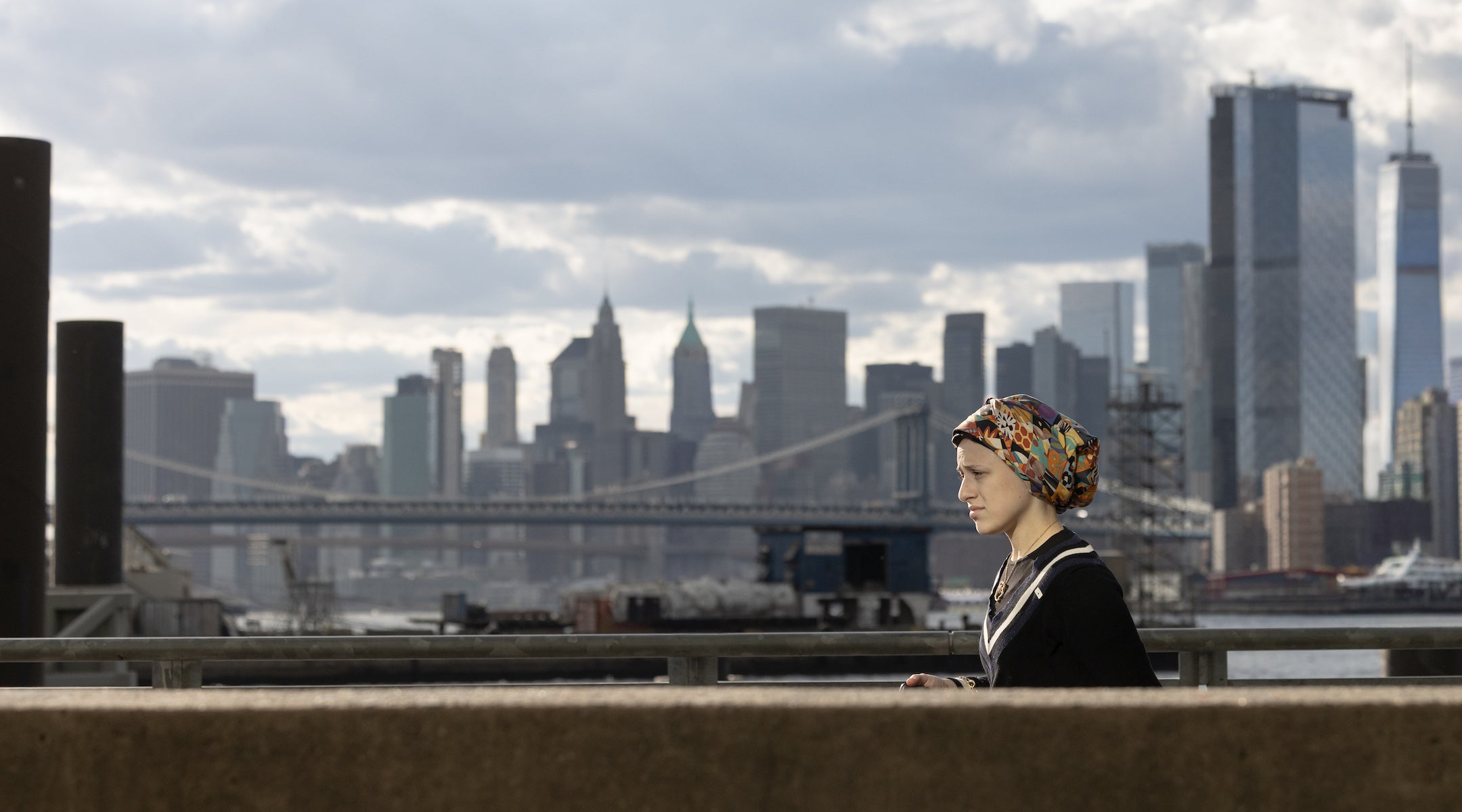
“A Bridge Apart” by Abe Kugielsky. (Courtesy Abe Kugielsky)
It really shifted to the point where, if I walk down Williamsburg, people stop me and ask me for a selfie, and people will DM me and say, ‘Hey, there’s an event going on here, please come down and photograph.” My goal was to go in deeper and deeper, more and more intimate, and I’ve gotten there. Especially this past summer, we had some invites into family life, which is a whole new level that I’ve been really trying to get to.
What kinds of reactions from the public to your work have surprised or challenged you?
Of course, I get a lot of antisemitic comments from time to time with DMs. Anyone who posts anything Jewish nowadays gets them, but I’ve had a lot of interesting positive feedback from non-Jews worldwide. I’ve had people in Iran reach out to me, and I’ve heard from people in Middle Eastern countries, in Germany, Poland. I think they love the concept where they can look into another culture, have a window into another culture, something they don’t get to see.
Do you have a favorite image from the exhibit, and what makes it stand out to you?
I have one great image that I really, really love. This was a silver shop in Borough Park I walked into and I asked the owner, an older Hasidic Jew, if I can photograph him, and his response is, “What do I need it for?”
I have an album on my phone with photos I downloaded from Brooklyn Public Library, old images from Williamsburg taken by a photographer in 1964, and I figured, let me show him what it looks like looking back at photos from 50 years ago. I started showing him on my phone. He was scrolling through the photos, and I said, look how beautiful it is to look at pictures from 50 years ago.
But then he froze on a certain picture, and his demeanor changes, and he goes, “This is my wife.” He found a picture of his wife and his first newborn son from 50 years ago in those photos, so I captured that moment where he’s really reminiscing about those years.
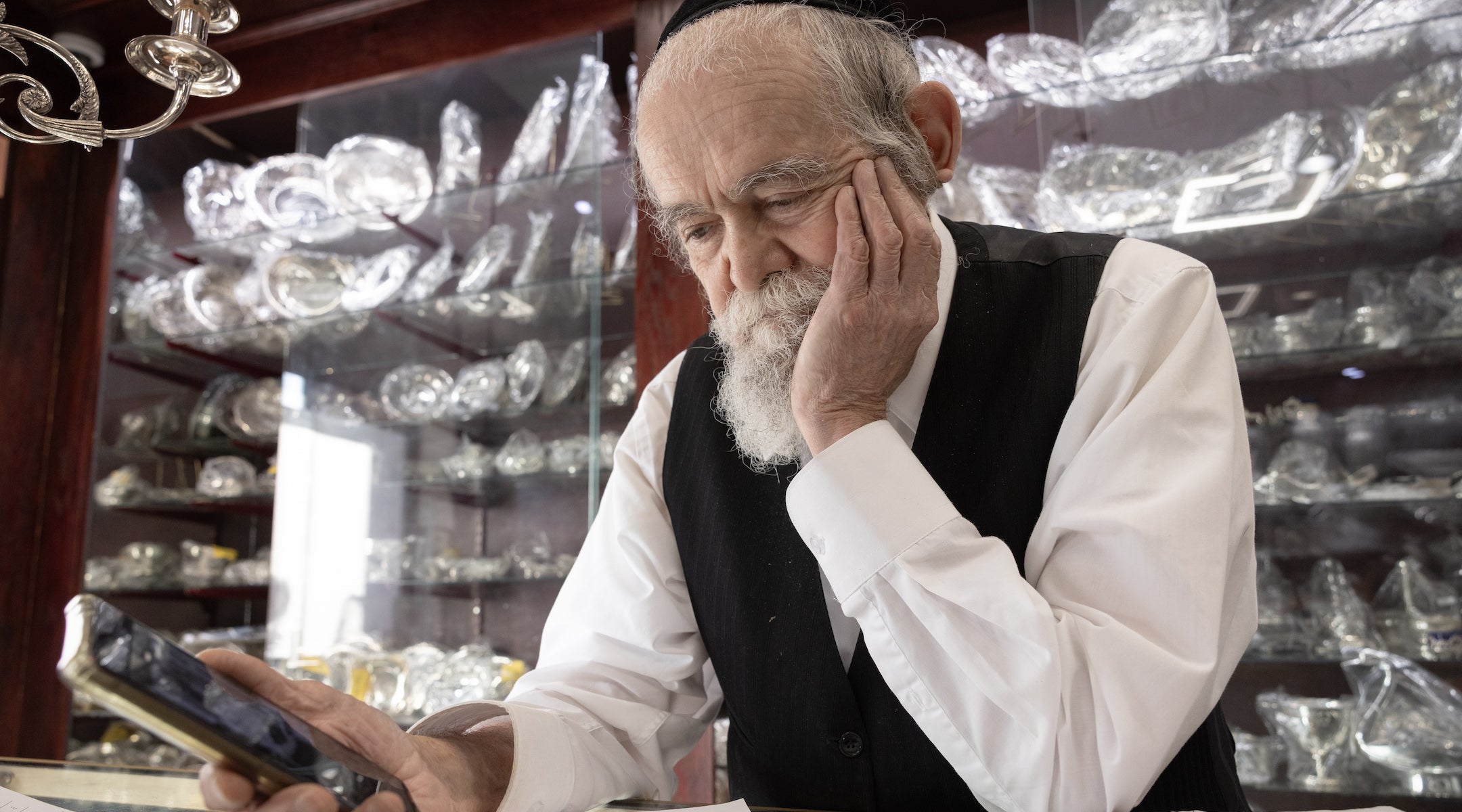
“Silver Memories” by Abe Kugielsky. (Courtesy Abe Kugielsky)
Humans of New York has drawn criticism for a series focused on aid workers in Gaza as well as for featuring a member of Neturei Karta, a small anti-Zionist sect of the Orthodox community. Was that something you thought about before deciding to participate?
I was tagged when he posted his request for people to submit. I didn’t follow him, it’s just not really my style of work, he’s more storytelling. I went into his page, and I saw all these posts, I wasn’t sure what to make of it.
The vibe that I got was I didn’t feel an antisemitism there. I felt like he was more going with the trend, showcasing Palestinians from Gaza or Neturei Karta, more from a place of ignorance.
I believe a lot of New Yorkers, a lot of Americans, a lot of people worldwide, don’t really know and understand the conflict. It’s just in style now to hate, and it’s in style now to side with one side or the other without really understanding.
I didn’t give it a lot of hope when I submitted my photos, and I was actually surprised that he chose my photos to be included, and throughout my conversations with him, I understood that he really doesn’t understand much of the conflict.
Have you received any critical feedback about your involvement in this project?
Very, very little. I think one or two people commented like, why would you do this? But for me, A, It’s an opportunity for me, for my work, to showcase my work out there more, and, B, I thought it was so important to have a representation of Jewish life, or Hasidic life, Orthodox life, in such an important exhibition.
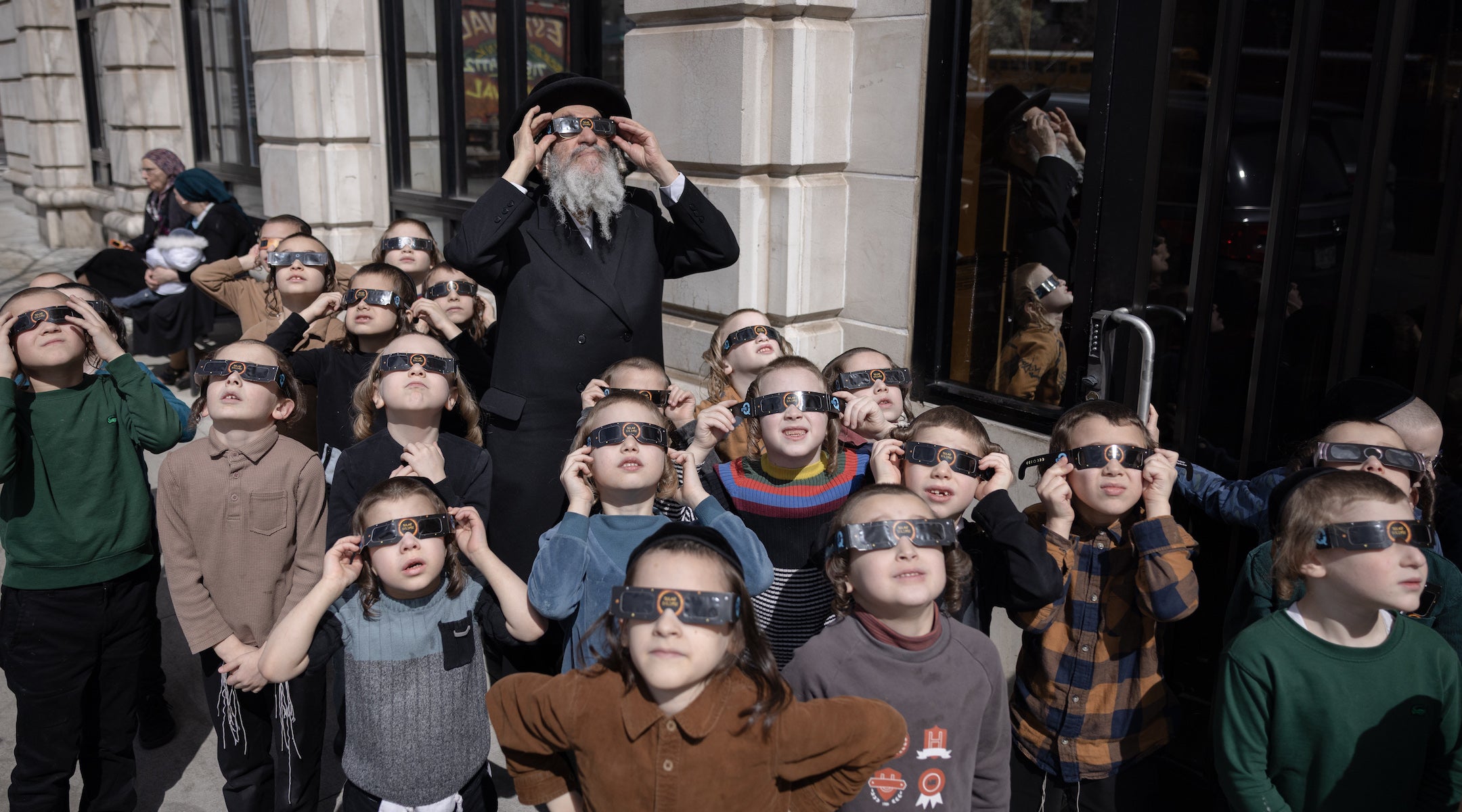
“Brooklyn Skies” by Abe Kugielsky. (Courtesy Abe Kugielsky)
What are you hoping people take away when they encounter your Grand Central exhibit?
What I’m expecting people to take away is really to see the humanistic side of this culture. People could be living literally a block away from the community, and not really know the community, and not understand them.
I’m hoping that this gives them a little bit more of a humanistic view of the Hasidic community, where they live, their life, their culture, their religion. After all, we’re all human, we all coexist in the same city.
—
The post How Abe Kugielsky’s photos of Hasidic Brooklyn ended up on display in Grand Central Terminal appeared first on Jewish Telegraphic Agency.


